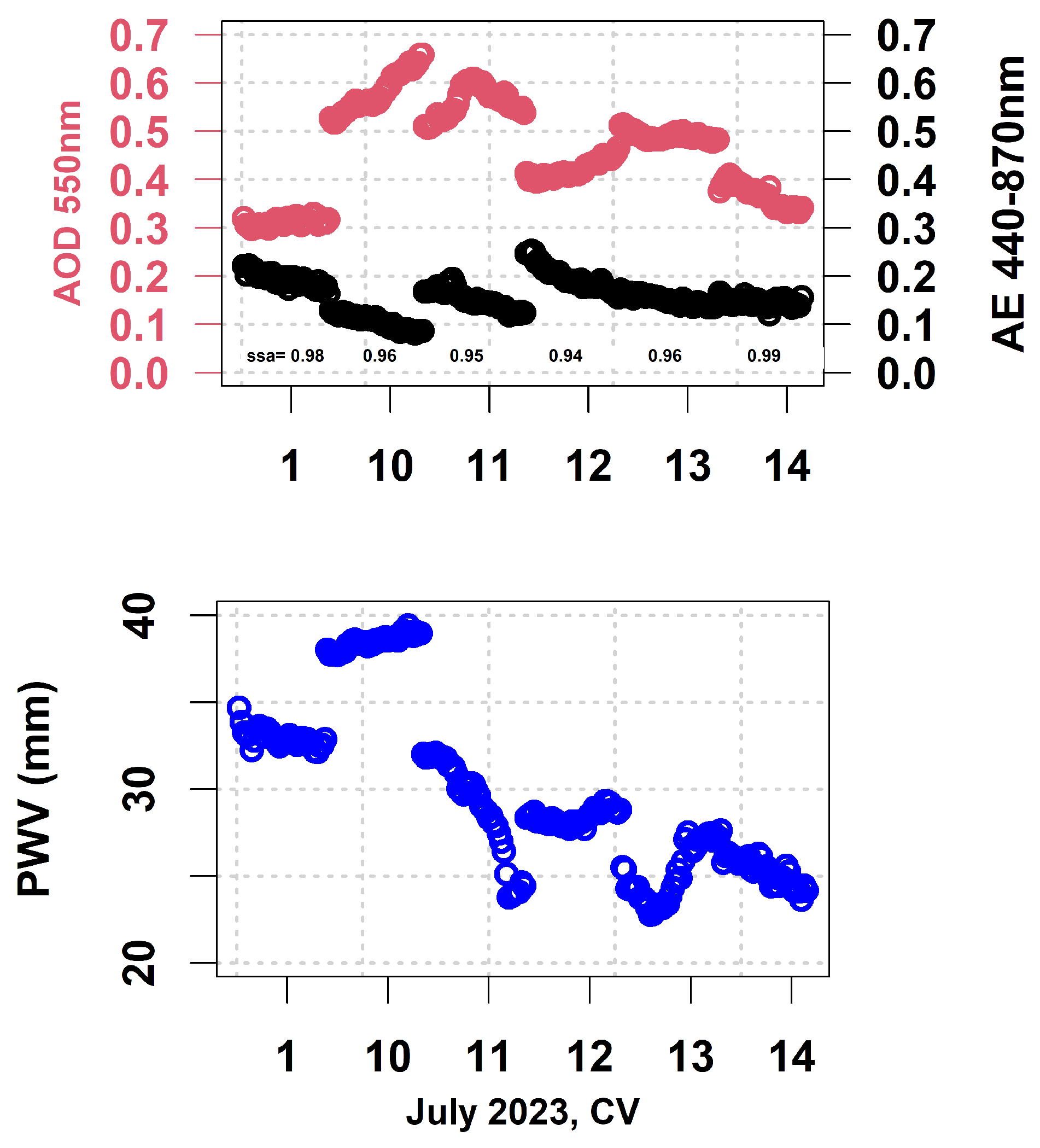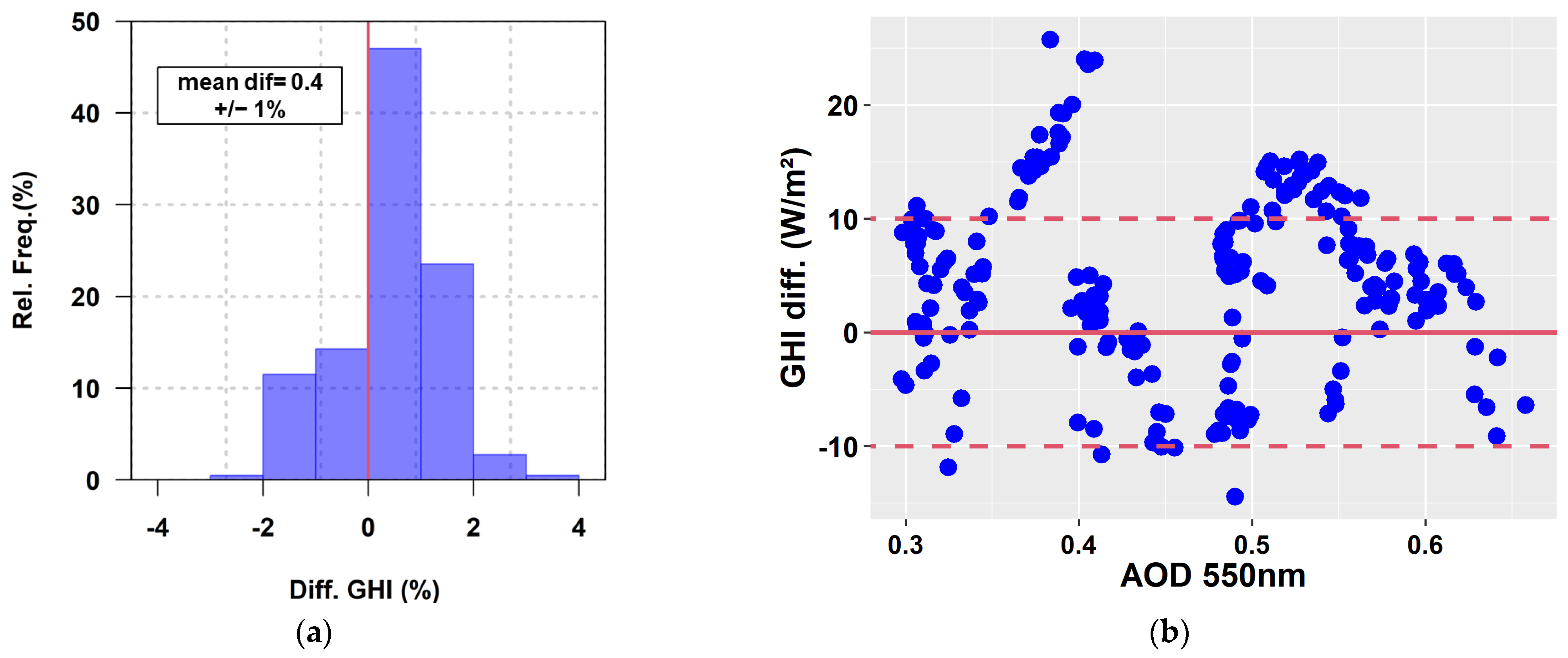Surface Shortwave Radiation Measurements and Modeling under Intense Desert Dust Conditions †
Abstract
:1. Introduction
2. Materials and Methods
3. Results and Discussion
3.1. Atmospheric Conditions
3.2. Shortwave Radiative Closure at Surface
4. Summary and Outlook
Author Contributions
Funding
 .
.Institutional Review Board Statement
Data Availability Statement
Acknowledgments
Conflicts of Interest
References
- Kok, J.F.; Storelvmo, T.; Karydis, V.A.; Adebiyi, A.A.; Mahowald, N.M.; Evan, A.T.; He, C.; Leung, D.M. Mineral Dust Aerosol Impacts on Global Climate and Climate Change. Nat. Rev. Earth Environ. 2023, 4, 71–86. [Google Scholar] [CrossRef]
- Adebiyi, A.; Kok, J.F.; Murray, B.J.; Ryder, C.L.; Stuut, J.B.W.; Kahn, R.A.; Knippertz, P.; Formenti, P.; Mahowald, N.M.; Pérez García-Pando, C.; et al. A Review of Coarse Mineral Dust in the Earth System. Aeolian Res. 2023, 60, 100849. [Google Scholar] [CrossRef]
- Ryder, C.L. Radiative Effects of Increased Water Vapor in the Upper Saharan Air Layer Associated with Enhanced Dustiness. J. Geophys. Res. Atmos. 2021, 126, e2021JD034696. [Google Scholar] [CrossRef]
- Russell, P.B.; Kinne, S.A.; Bergstrom, R.W. Aerosol Climate Effects: Local Radiative Forcing and Column Closure Experiments. J. Geophys. Res. Atmos. 1997, 102, 9397–9407. [Google Scholar] [CrossRef]
- Mayer, B.; Kylling, A. Technical Note: The LibRadtran Software Package for Radiative Transfer Calculations-Description and Examples of Use. Atmos. Chem. Phys. 2005, 5, 1855–1877. [Google Scholar] [CrossRef]
- Emde, C.; Buras-Schnell, R.; Kylling, A.; Mayer, B.; Gasteiger, J.; Hamann, U.; Kylling, J.; Richter, B.; Pause, C.; Dowling, T.; et al. The LibRadtran Software Package for Radiative Transfer Calculations (Version 2.0.1). Geosci. Model Dev. 2016, 9, 1647–1672. [Google Scholar] [CrossRef]


| Parameter | |
|---|---|
| Cimel/AERONET Level 1.5 products | Aerosol Optical Depth (AOD) at 500 nm |
| Angstrom Exponent (AE) 440–675 nm | |
| Single Scattering Albedo (SSA), mean from 440–500–675–870 nm | |
| Precipitable Water Vapor (PWV) | |
| Pyranometer (280–2800 nm) | Global Horizontal Irradiance |
| (GHI) |
| Day | AOD | AE | SSA | PWV (mm) | SZA (°) Range | GHI Diff. (W/m2) | GHI Diff. % |
|---|---|---|---|---|---|---|---|
| 01 July | 0.31 ± 0.01 | 0.19 ± 0.01 | 0.98 | 32.9 ± 0.4 | 8.7–50.9 | 3.5 ± 6.0 | 0.4 ± 0.7 |
| 10 July | 0.58 ± 0.04 | 0.11 ± 0.02 | 0.96 | 38.5 ± 0.4 | 6.5–53.1 | 6.6 ± 6.4 | 0.7 ± 0.8 |
| 11 July | 0.56 ± 0.03 | 0.15 ± 0.02 | 0.95 | 29.1 ± 2.7 | 6.3–54.0 | 5.2 ± 6.3 | 0.6 ± 0.8 |
| 12 July | 0.42 ± 0.02 | 0.20 ± 0.03 | 0.94 | 28.4 ± 0.4 | 7.0–54.3 | −1.3 ± 4.9 | −0.3 ± 0.7 |
| 13 July | 0.49 ± 0.01 | 0.15 ± 0.01 | 0.96 | 25.1 ± 1.7 | 6.3–54.2 | 1.1 ± 7.6 | 0 ± 1.0 |
| 14 July | 0.37 ± 0.02 | 0.15 ± 0.01 | 0.99 | 25.3 ± 0.8 | 6.1–45.0 | 12.4 ± 7.8 | 1.4 ± 0.8 |
Disclaimer/Publisher’s Note: The statements, opinions and data contained in all publications are solely those of the individual author(s) and contributor(s) and not of MDPI and/or the editor(s). MDPI and/or the editor(s) disclaim responsibility for any injury to people or property resulting from any ideas, methods, instructions or products referred to in the content. |
© 2023 by the authors. Licensee MDPI, Basel, Switzerland. This article is an open access article distributed under the terms and conditions of the Creative Commons Attribution (CC BY) license (https://creativecommons.org/licenses/by/4.0/).
Share and Cite
Papachristopoulou, K.; Tsekeri, A.; Kouklaki, D.; Raptis, P.I.; Marinou, E.; Amiridis, V.; Fountoulakis, I.; Kazadzis, S. Surface Shortwave Radiation Measurements and Modeling under Intense Desert Dust Conditions. Environ. Sci. Proc. 2023, 26, 15. https://doi.org/10.3390/environsciproc2023026015
Papachristopoulou K, Tsekeri A, Kouklaki D, Raptis PI, Marinou E, Amiridis V, Fountoulakis I, Kazadzis S. Surface Shortwave Radiation Measurements and Modeling under Intense Desert Dust Conditions. Environmental Sciences Proceedings. 2023; 26(1):15. https://doi.org/10.3390/environsciproc2023026015
Chicago/Turabian StylePapachristopoulou, Kyriakoula, Alexandra Tsekeri, Dimitra Kouklaki, Panagiotis Ioannis Raptis, Eleni Marinou, Vasilis Amiridis, Ilias Fountoulakis, and Stelios Kazadzis. 2023. "Surface Shortwave Radiation Measurements and Modeling under Intense Desert Dust Conditions" Environmental Sciences Proceedings 26, no. 1: 15. https://doi.org/10.3390/environsciproc2023026015
APA StylePapachristopoulou, K., Tsekeri, A., Kouklaki, D., Raptis, P. I., Marinou, E., Amiridis, V., Fountoulakis, I., & Kazadzis, S. (2023). Surface Shortwave Radiation Measurements and Modeling under Intense Desert Dust Conditions. Environmental Sciences Proceedings, 26(1), 15. https://doi.org/10.3390/environsciproc2023026015









